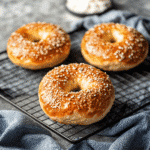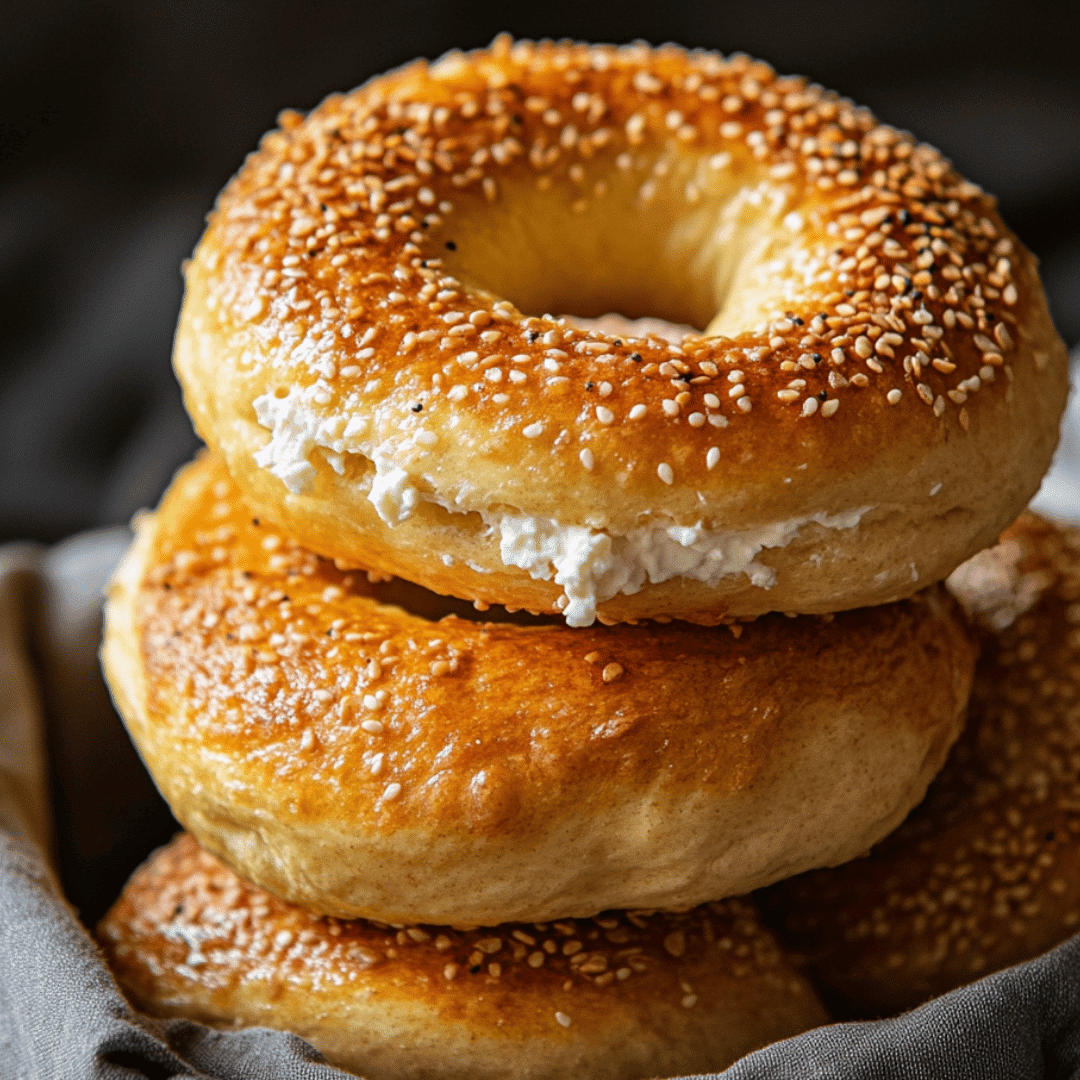High-protein cottage cheese bagels have become a go-to in my kitchen—and not just for the gains. They’re quick, delicious, and surprisingly satisfying for how simple the ingredients are. In this article, you’ll get my full step-by-step cottage cheese bagels recipe, packed with protein and perfect for any time of day. Whether you’re into meal prep, cutting carbs, or just trying to feel good about breakfast again, these bagels check every box. Along the way, we’ll answer common questions like how to store them, what toppings work best, and why cottage cheese is the real MVP.
The Story Behind These High Protein Cottage Cheese Bagels
From Chicago Deli to Protein Dough Magic
I grew up in the back of my parents’ deli on the north side of Chicago. Picture stacks of provolone, the smell of roasted peppers, and my dad elbow-deep in flour—always improvising. Back then, bagels were dense, golden, and always smeared with cream cheese or layered with mortadella. Fast-forward a couple decades, and here I am, obsessed with macros and sous vide, looking for ways to keep the flavor without the food coma.
The first time I tried making bagels with cottage cheese, I expected a chewy disaster. But after a few rounds of testing, something clicked. When paired with the right flour and technique, cottage cheese doesn’t just work—it transforms the texture into something pillowy and moist with this subtle tang that’s kind of addictive. Plus, the protein content? Off the charts.
Why Cottage Cheese Is a Game-Changer for Bagels
Using cottage cheese in bagels isn’t just a clever protein hack—it changes the structure of the dough. You get softness without needing extra fat, and it binds beautifully without added oil. And because these are naturally lower in carbs and higher in protein, they’ve become a staple in my fridge for everything from breakfast sandwiches to post-workout snacks.
I like to pair one with my favorite spread from this cowboy butter recipe or use them as a base for sous vide deviled eggs when I want a double protein hit. Whether you’re meal prepping or just craving something warm, these bagels deliver the goods.
Ingredients & Smart Substitutions for Protein Bagels
What You Need to Make High Protein Cottage Cheese Bagels

You’ll be surprised at how few ingredients go into this high protein cottage cheese bagels recipe—and how versatile it really is. At the core, you only need:
- Cottage cheese: Full-fat or low-fat both work, but aim for 4% milkfat if you want extra richness without drying out the dough.
- Eggs: These add structure and another boost of protein.
- Self-rising flour: Or a mix of all-purpose flour with baking powder and a pinch of salt.
- Optional: Greek yogurt (for extra tang), or a scoop of unflavored protein powder if you’re serious about macro goals.
This dough comes together fast—no yeast, no kneading, and no waiting for a rise. That’s one reason it’s become a favorite in my kitchen, right up there with fast-prep dishes like this sous vide chicken thighs recipe or my weeknight go-to salt beef sous vide.
Easy Swaps for Dietary Needs and Flavor Boosts
Looking to lower carbs? You can sub in almond flour or oat flour, but the texture will be softer and a little more crumbly. Want extra flavor? Try stirring in everything bagel seasoning or shredded cheddar right into the dough. I’ve even used chopped jalapeños and it worked like a charm.
For dairy-free eaters, almond milk yogurt and egg replacers work, but the structure suffers a bit. It won’t be quite the same, but it’ll still taste good. That’s the beauty of this high protein cottage cheese bagels recipe—it’s flexible enough to fit nearly every lifestyle.
I often pair these with something fancy like sous vide scallops or go sweet with a swipe of homemade pinon ice cream on top. Sweet, savory, or plain—you really can’t go wrong.
How to Make High Protein Cottage Cheese Bagels Recipe Step-by-Step
Quick Method for a Foolproof High Protein Cottage Cheese Bagels

Making this high protein cottage cheese bagels is so simple, you’ll wonder why you ever bought store-bought bagels. Here’s how I do it, from start to finish. Preheat your oven to 375°F. Line a baking sheet with parchment paper and lightly spray it to avoid sticking. In a large mixing bowl, combine 1 cup of cottage cheese, 1 large egg, and 1 cup of self-rising flour. Stir until it forms a shaggy dough.
Next, turn the dough out onto a floured surface and knead it gently—just enough to bring it together. Divide into four equal parts, then roll each one into a rope and shape into a bagel. Brush the tops with egg wash for that beautiful golden crust.
Bake for 22–25 minutes until golden brown. You’ll smell it when they’re ready—that deep, bready aroma that only a fresh high protein cottage cheese bagels recipe delivers. For bonus flavor, I sometimes finish them under the broiler for a minute or two to crisp the top.
Pro Tips to Nail This High Protein Cottage Cheese Bagels Recipe
Want a fluffier result? Use a food processor to blend the cottage cheese until smooth before mixing. This distributes moisture evenly through the dough. Want a deeper crust? Use a convection setting if your oven has one.
If you’re already hooked on creative, macro-friendly recipes like these sous vide turkey breast or sous vide chicken wings, this high protein cottage cheese bagels recipe belongs right in your weekly meal prep.
Whether you top them with hummus, smash an egg in the center, or serve them alongside your sous vide filet mignon, these bagels are about to become your new favorite high-protein essential.
When and How to Serve These Protein Bagels
This high protein cottage cheese bagels recipe shines at breakfast, but don’t limit yourself. I use them as post-workout fuel or even as buns for sous vide tri tip sandwiches. Toast one, top it, love it.
Whether paired with sous vide scallops with lemon butter sauce or served solo, these bagels are the kind of recipe you come back to weekly.

Better Bagels, Better Mornings
This high protein cottage cheese bagels recipe isn’t just another food trend—it’s a functional, flavorful way to bring balance back to your mornings. Whether you’re counting macros, cutting carbs, or just want to feel fuller longer, these bagels are the answer. They bake fast, store well, and taste just as good reheated. I keep a batch in my fridge every week—and you might start doing the same.
Want to dig deeper into protein-rich eating? This NIH article on protein and muscle health explains why protein timing and quality matter. Curious about cottage cheese’s role in fitness? Healthline’s guide to cottage cheese benefits is packed with reasons to love it. And if you’re looking for even more protein-packed meal ideas, Bodybuilding.com’s high-protein meal list offers endless inspiration.
So go on—print this recipe, share it, tweak it, and enjoy every chewy, protein-rich bite. And if you try it, let me know how you topped yours.
FAQs: High Protein Cottage Cheese Bagels Recipe
Are cottage cheese bagels gluten-free?
Not by default. Most versions use self-rising or all-purpose flour. But you can use gluten-free flour blends or almond flour to make a gluten-free version of this high protein cottage cheese bagels recipe.
Can I use ricotta instead of cottage cheese?
Yes, but your bagels will be softer and less structured. Ricotta has more moisture and less protein, which may impact the final texture of your high protein cottage cheese bagels recipe.
Is this recipe suitable for weight loss?
Definitely. These bagels are lower in carbs and higher in protein than traditional bagels, making them great for meal prep or macro-based diets.
Can I make the dough in advance?
Yes. Store the dough wrapped in plastic in the fridge for up to 24 hours. When ready, shape and bake as directed. This makes the high protein cottage cheese bagels recipe even more convenient.
Table of Contents

High Protein Cottage Cheese Bagels Recipe
- Total Time: 35 mins
- Yield: 4 bagels 1x
- Diet: Gluten Free
Description
This high protein cottage cheese bagels recipe is easy, macro-friendly, and ready in under 30 minutes. Soft, chewy, and perfect for meal prep
Ingredients
1 cup cottage cheese (4% fat)
1 cup self-rising flour
1 large egg
Optional: 1 tbsp Greek yogurt
Optional: 1 scoop unflavored protein powder
Egg wash (1 egg beaten)
Instructions
Preheat oven to 375°F and line a baking sheet with parchment paper.
In a bowl, mix cottage cheese, egg, and flour until a dough forms.
Knead gently and divide into 4 portions. Roll into bagel shapes.
Brush tops with egg wash.
Bake for 22–25 minutes until golden brown.
Cool before serving or storing.
Notes
Use a food processor for smoother dough texture.
Add everything seasoning or shredded cheese for flavor.
Store in fridge up to 5 days or freeze up to 2 months
- Prep Time: 10 mins
- Cook Time: 25 mins
- Category: Breakfast, High Protein
- Method: Baked
- Cuisine: American
Nutrition
- Serving Size: 1 bagel
- Calories: 170
- Sugar: 2g
- Sodium: 290mg
- Fat: 5g
- Saturated Fat: 2g
- Unsaturated Fat: 3g
- Trans Fat: 0g
- Carbohydrates: 17g
- Fiber: 1g
- Protein: 14g
- Cholesterol: 55mg

